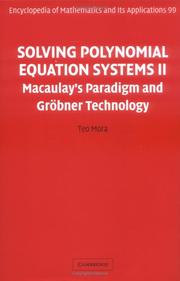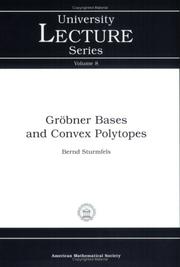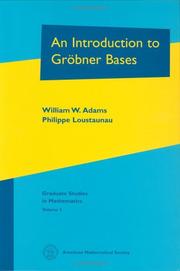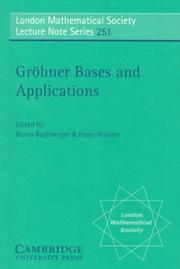| Listing 1 - 10 of 15 | << page >> |
Sort by
|
Book
ISBN: 9814365149 9789814365147 1299671837 9781299671836 9789814365130 9814365130 Year: 2012 Publisher: New Jersey World Scientific
Abstract | Keywords | Export | Availability | Bookmark
 Loading...
Loading...Choose an application
- Reference Manager
- EndNote
- RefWorks (Direct export to RefWorks)
This monograph strives to introduce a solid foundation on the usage of Gröbner bases in ring theory by focusing on noncommutative associative algebras defined by relations over a field K. It also reveals the intrinsic structural properties of Gröbner bases, presents a constructive PBW theory in a quite extensive context and, along the routes built via the PBW theory, the book demonstrates novel methods of using Gröbner bases in determining and recognizing many more structural properties of algebras, such as the Gelfand-Kirillov dimension, Noetherianity, (semi-)primeness, PI-property, finitenes
Gröbner bases. --- Rings (Algebra) --- Gröbner basis theory --- Commutative algebra --- Algebraic rings --- Ring theory --- Algebraic fields --- Gröbner, Wolfgang, --- Gröbner, W.
Book

ISBN: 3110922754 9783110922752 9783110193237 311019323X Year: 2011 Publisher: Berlin Boston
Abstract | Keywords | Export | Availability | Bookmark
 Loading...
Loading...Choose an application
- Reference Manager
- EndNote
- RefWorks (Direct export to RefWorks)
This volume contains survey articles and original research papers, presenting the state of the art on applying the symbolic approach of Gröbner bases and related methods to differential and difference equations. The contributions are based on talks delivered at the Special Semester on Gröbner Bases and Related Methods hosted by the Johann Radon Institute of Computational and Applied Mathematics, Linz, Austria, in May 2006.
Gröbner bases --- Differential equations --- 517.91 Differential equations --- Gröbner basis theory --- Commutative algebra --- Kongress. --- Linz <2006> --- Algebras. --- base. --- ideal. --- polynomial. --- sybolic computation.

ISBN: 9781107340954 9780521811569 1107340950 9781107266902 1107266904 9781299707610 1299707610 9781107269989 1107269989 9780521811545 0521811546 0521811562 9780521811552 0521811554 1139883003 1107266556 110726443X 1107263344 1107267978 9781139015998 Year: 2005 Volume: v. 99 Publisher: Cambridge Cambridge University Press
Abstract | Keywords | Export | Availability | Bookmark
 Loading...
Loading...Choose an application
- Reference Manager
- EndNote
- RefWorks (Direct export to RefWorks)
The second volume of this comprehensive treatise focusses on Buchberger theory and its application to the algorithmic view of commutative algebra. In distinction to other works, the presentation here is based on the intrinsic linear algebra structure of Groebner bases, and thus elementary considerations lead easily to the state-of-the-art in issues of implementation. The same language describes the applications of Groebner technology to the central problems of commutative algebra. The book can be also used as a reference on elementary ideal theory and a source for the state-of-the-art in its algorithmization. Aiming to provide a complete survey on Groebner bases and their applications, the author also includes advanced aspects of Buchberger theory, such as the complexity of the algorithm, Galligo's theorem, the optimality of degrevlex, the Gianni-Kalkbrener theorem, the FGLM algorithm, and so on. Thus it will be essential for all workers in commutative algebra, computational algebra and algebraic geometry.
Equations --- Polynomials. --- Iterative methods (Mathematics) --- Iteration (Mathematics) --- Numerical analysis --- Algebra --- Numerical solutions. --- Graphic methods --- Gröbner bases. --- Gröbner basis theory --- Commutative algebra

ISBN: 0821804871 9780821804872 Year: 1996 Volume: 8 Publisher: Providence (R.I.) American Mathematical Society
Abstract | Keywords | Export | Availability | Bookmark
 Loading...
Loading...Choose an application
- Reference Manager
- EndNote
- RefWorks (Direct export to RefWorks)
Ordered algebraic structures --- Gröbner bases --- Convex polytopes --- 512.62 --- Grobner bases --- Polytopes --- Gröbner basis theory --- Commutative algebra --- Fields. Polynomials --- Convex polytopes. --- Gröbner bases. --- 512.62 Fields. Polynomials --- Gröbner bases

ISBN: 0821838040 9780821838044 Year: 1994 Volume: 3 Publisher: Providence (R.I.): American Mathematical Society
Abstract | Keywords | Export | Availability | Bookmark
 Loading...
Loading...Choose an application
- Reference Manager
- EndNote
- RefWorks (Direct export to RefWorks)
Book
ISBN: 128066987X 9786613646804 9814383465 9789814383462 9814383457 9789814383455 Year: 2012 Publisher: Singapore : World Scientific Pub. Co.,
Abstract | Keywords | Export | Availability | Bookmark
 Loading...
Loading...Choose an application
- Reference Manager
- EndNote
- RefWorks (Direct export to RefWorks)
This volume consists of research papers and expository survey articles presented by the invited speakers of the conference on "Harmony of Gröbner Bases and the Modern Industrial Society". Topics include computational commutative algebra, algebraic statistics, algorithms of D-modules and combinatorics. This volume also provides current trends on Gröbner bases and will stimulate further development of many research areas surrounding Gröbner bases.
Gröbner bases --- Gröbner basis theory --- Commutative algebra --- Developed countries --- Advanced countries --- Advanced nations --- Developed nations --- Economically advanced countries --- Economically advanced nations --- First World --- Industrial countries --- Industrial nations --- Industrial societies --- Industrialized countries --- Industrialized nations --- Western countries
Book
ISBN: 311090974X 9783110909746 3110193337 9783110193336 Year: 2007 Publisher: Berlin New York Walter de Gruyter
Abstract | Keywords | Export | Availability | Bookmark
 Loading...
Loading...Choose an application
- Reference Manager
- EndNote
- RefWorks (Direct export to RefWorks)
This volume contains survey and original articles presenting the state of the art on the application of Gröbner bases in control theory and signal processing. The contributions are based on talks delivered at the Special Semester on Gröbner Bases and Related Methods at the Johann Radon Institute of Computational and Applied Mathematics (RICAM), Linz, Austria, in May 2006.
Gröbner bases. --- Control theory. --- Signal processing. --- Processing, Signal --- Information measurement --- Signal theory (Telecommunication) --- Dynamics --- Machine theory --- Gröbner basis theory --- Commutative algebra --- Algebras. --- base. --- control theory. --- signal theory. --- Grobner bases.
Book
ISBN: 4431545735 4431545743 Year: 2013 Publisher: Tokyo : Springer Japan : Imprint: Springer,
Abstract | Keywords | Export | Availability | Bookmark
 Loading...
Loading...Choose an application
- Reference Manager
- EndNote
- RefWorks (Direct export to RefWorks)
The idea of the Gröbner basis first appeared in a 1927 paper by F. S. Macaulay, who succeeded in creating a combinatorial characterization of the Hilbert functions of homogeneous ideals of the polynomial ring. Later, the modern definition of the Gröbner basis was independently introduced by Heisuke Hironaka in 1964 and Bruno Buchberger in 1965. However, after the discovery of the notion of the Gröbner basis by Hironaka and Buchberger, it was not actively pursued for 20 years. A breakthrough was made in the mid-1980s by David Bayer and Michael Stillman, who created the Macaulay computer algebra system with the help of the Gröbner basis. Since then, rapid development on the Gröbner basis has been achieved by many researchers, including Bernd Sturmfels. This book serves as a standard bible of the Gröbner basis, for which the harmony of theory, application, and computation are indispensable. It provides all the fundamentals for graduate students to learn the ABC’s of the Gröbner basis, requiring no special knowledge to understand those basic points. Starting from the introductory performance of the Gröbner basis (Chapter 1), a trip around mathematical software follows (Chapter 2). Then comes a deep discussion of how to compute the Gröbner basis (Chapter 3). These three chapters may be regarded as the first act of a mathematical play. The second act opens with topics on algebraic statistics (Chapter 4), a fascinating research area where the Gröbner basis of a toric ideal is a fundamental tool of the Markov chain Monte Carlo method. Moreover, the Gröbner basis of a toric ideal has had a great influence on the study of convex polytopes (Chapter 5). In addition, the Gröbner basis of the ring of differential operators gives effective algorithms on holonomic functions (Chapter 6). The third act (Chapter 7) is a collection of concrete examples and problems for Chapters 4, 5 and 6 emphasizing computation by using various software systems.
Gröbner bases. --- Mathematics --- Physical Sciences & Mathematics --- Algebra --- Gröbner basis theory --- Statistics. --- Statistical Theory and Methods. --- Statistics and Computing/Statistics Programs. --- Statistics for Engineering, Physics, Computer Science, Chemistry and Earth Sciences. --- Commutative algebra --- Mathematical statistics. --- Statistical analysis --- Statistical data --- Statistical methods --- Statistical science --- Econometrics --- Statistical inference --- Statistics, Mathematical --- Statistics --- Probabilities --- Sampling (Statistics) --- Statistics .
Book
ISBN: 3030039048 303003903X Year: 2018 Publisher: Cham : Springer International Publishing : Imprint: Springer,
Abstract | Keywords | Export | Availability | Bookmark
 Loading...
Loading...Choose an application
- Reference Manager
- EndNote
- RefWorks (Direct export to RefWorks)
This book is divided into two parts, one theoretical and one focusing on applications, and offers a complete description of the Canonical Gröbner Cover, the most accurate algebraic method for discussing parametric polynomial systems. It also includes applications to the Automatic Deduction of Geometric Theorems, Loci Computation and Envelopes. The theoretical part is a self-contained exposition on the theory of Parametric Gröbner Systems and Bases. It begins with Weispfenning’s introduction of Comprehensive Gröbner Systems (CGS) in 1992, and provides a complete description of the Gröbner Cover (GC), which includes a canonical discussion of a set of parametric polynomial equations developed by Michael Wibmer and the author. In turn, the application part selects three problems for which the Gröbner Cover offers valuable new perspectives. The automatic deduction of geometric theorems (ADGT) becomes fully automatic and straightforward using GC, representing a major improvement on all previous methods. In terms of loci and envelope computation, GC makes it possible to introduce a taxonomy of the components and automatically compute it. The book also generalizes the definition of the envelope of a family of hypersurfaces, and provides algorithms for its computation, as well as for discussing how to determine the real envelope. All the algorithms described here have also been included in the software library “grobcov.lib” implemented in Singular by the author, and serve as a User Manual for it.
Gröbner bases. --- Gröbner basis theory --- Commutative algebra --- Algebra. --- Field theory (Physics). --- Algebra --- Commutative Rings and Algebras. --- Field Theory and Polynomials. --- Symbolic and Algebraic Manipulation. --- Data processing. --- Classical field theory --- Continuum physics --- Physics --- Continuum mechanics --- Mathematics --- Mathematical analysis --- Commutative algebra. --- Commutative rings. --- Computer science—Mathematics. --- Rings (Algebra)

ISBN: 113988543X 1107365147 1107362695 1107367603 110737216X 1107369355 0511565844 9781107362697 9780511565847 0521632986 9780521632980 Year: 1998 Publisher: Cambridge, U.K. New York Cambridge University Press
Abstract | Keywords | Export | Availability | Bookmark
 Loading...
Loading...Choose an application
- Reference Manager
- EndNote
- RefWorks (Direct export to RefWorks)
This book provides an easy-to-read account of the theory of Gröbner bases and applications. It is in 2 parts, the first consists of tutorial lectures, and the second, 17 original research papers on Gröbner bases.
Gröbner bases. --- Coding theory --- Gröbner basis theory --- Commutative algebra --- Geometry, Algebraic --- Géométrie algébrique. --- Algorithms --- Algorithmes. --- Anneaux de polynômes. --- Polynomial rings. --- Algèbres commutatives. --- Polynômes --- Polynomials --- 512.56 --- 512.56 Lattices, including Boolean rings and algebras --- Lattices, including Boolean rings and algebras --- Grobner bases. --- Géométrie algébrique --- Algorithmes --- Anneaux de polynômes. --- Algèbres commutatives. --- Polynômes
| Listing 1 - 10 of 15 | << page >> |
Sort by
|

 Search
Search Feedback
Feedback About UniCat
About UniCat  Help
Help News
News